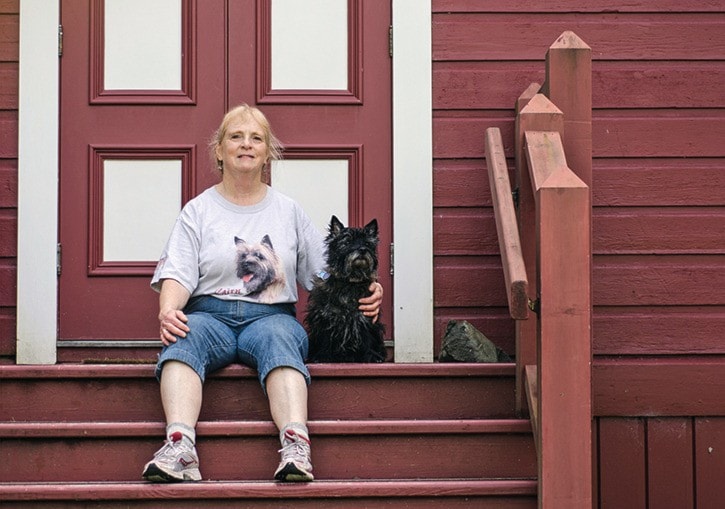Pattie Whitehouse sits among a handful of empty seats in the Little Red Schoolhouse.This is political engagement at its finest.
The cramped former one-room school in Highlands, now used to host bi-weekly municipal council meetings, has poor acoustics, so Whitehouse usually takes a front-row seat to better hear discussion among mayor and council.
“I also watch everybody’s expression from there, which is part of the entertainment,” she says.
Whitehouse is a Highlands council regular. Most municipalities have an attendee or two who sits through every meeting, keeping tabs on the goings-on in their community. Many of them know their respective official community plan and bylaws requirements as well as – if not better than – their elected officials.
“It’s a great way to not just keep on top of what’s going on in the community, but to understand what the different point of views are, how decision get to be made, and what happens when something goes awry,” she says.
And while most nights Whitehouse, 62, sits among a sparse crowd, she fears this basic level of engagement would be lost if the Capital Region’s 13 municipalities amalgamated in one form or another.
“I think that the majority of the decisions that would be made and discussed (by an amalgamated council) would not have a lot of relevance to me. I would be fearful that the character of the Highlands would be run roughshod over, and we would lose what we have here,” she says. “We don’t run into the kinds of problems that the big centres do.”
Despite having urban, suburban and rural parts to his municipality, Saanich Mayor Frank Leonard agrees.
As an outspoken proponent of integration rather than amalgamation, he says his municipality has more in common with Mainland communities like Delta and Abbotsford – part urban, part rural, part farmland – than next-door neighbour Victoria.
“We’re a large municipality with so much diversity. The things that we have in common with our neighbours are only in pockets,” he says. “We have issues on our agenda and in my office that my neighbours don’t have.”
Both Whitehouse and Leonard believe amalgamation would also have a negative impact on the sense of community.
It’s a sentiment shared by four communities in Queensland, Australia, whose residents last month voted to de-amalgamate from a regional government.
An article from The Courier-Mail said residents felt “their identity was stolen from them” upon forced amalgamation in 2008.
“This is about protecting our special place. It’s also about the way we engage. People here are very community minded and like to be listened to,” Sunshine Coast Coun. Russell Green told The Courier-Mail.
John Vickers, spokesperson for Amalgamation Yes, a grassroots Victoria-based organization that aims to raise awareness of amalgamation in the CRD, acknowledges that another downside is residents could wind up paying more to get the same level of service that they’re used to.
“Some areas you’re going to maybe spend more, some areas you’re going to spend less. I think we’ve got to just remind ourselves that we’re all part of one greater community,” he says. “We have a responsibility, as all community members do, to ensure we have the best (services) that we, as taxpayers, can obtain for our region.”
Gloria McCluskey, the former mayor of Dartmouth who was in power when Halifax amalgamation was forced upon the region in 1996, says the areas that aren’t urbanized tend to get lost in the shuffle amid regional governance. She fears the same thing would happen in the CRD.
“If (Greater) Victoria does this, (the City of) Victoria will be the benefactor. The rest might as well hang up their closed signs,” she says.
In Halifax, McCluskey points to a loss in basic such services as road and sidewalk repairs (money from the regional pot instead went elsewhere, as opposed to Dartmouth), and invasive species removal at Dartmouth parks as some of the most glaring impacts of amalgamation.
“Were there any positives in amalgamation? I can’t say yes,” McCluskey says.
It’s the same story for Whitehouse in Highlands, who says she sees benefits in finding service efficiencies, but doesn’t see how political amalgamation would be for the greater good.
“When communities are too large, you don’t have the sense of belonging, ownership or being responsible for them anymore,” she said. “I get a sense of ownership of the community, not just belonging to the community. I therefore feel that whatever happens with it, I have a piece in that. And I say that not because I attend council meetings, but because I express my opinions on the issues that come up and affect my community.”
Leonard says he strives to find efficiencies wherever he can, but amalgamation – as he sees it – wouldn’t be a financial benefit to Saanich residents. Personally, too, as mayor he can’t look at amalgamation with an impartial view.
“I’ve come into this municipal hall for 27 years in which every meeting I’m working to try to make Saanich an even better place to live,” he says. “I don’t know if I could objectively engage in discussion for ways to try and do away with the municipality.”
kslavin@saanichnews.com
What’s in a name?
While there isn’t much of a difference anymore between a city, town or a district, the reason Saanich is classified as a district (as opposed to a village) and Esquimalt is classified a township (as opposed to a city) stems from population and area at the time of incorporation.
-A village is less than 2,500 residents
-A town is 2,500 to 5,000 residents
-A city is more than 5,000 residents
-A district can have any population, but if the area is greater than 800 hectares with a population density of less than 5 people per hectare, it’s classified as a district
-A township is a historic classification, but is synonymous with a district
